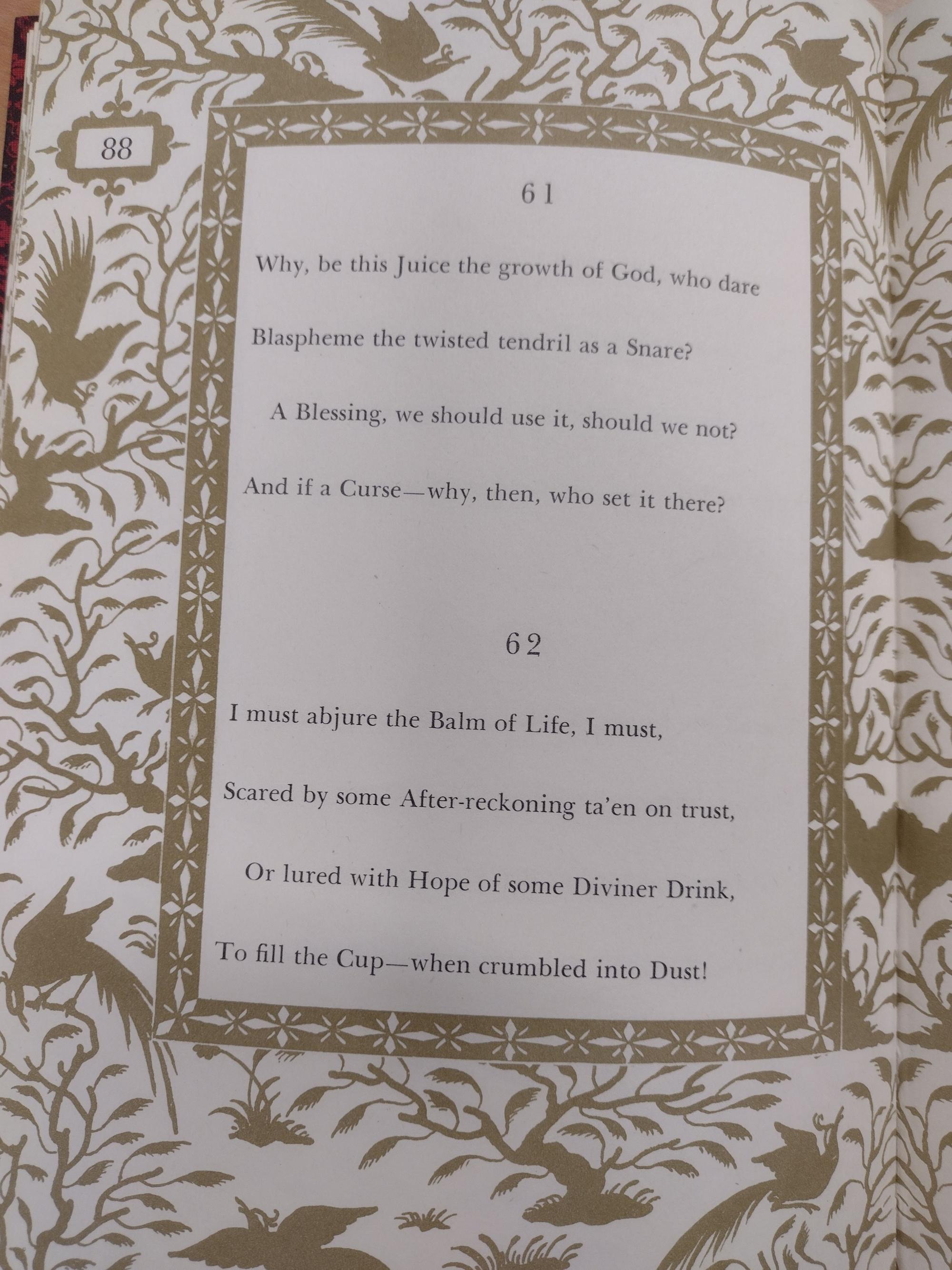Created by Lucas Yao on Sat, 05/13/2023 - 17:29
Description:
The illustration on page 89 depicts the act of contemplating the questions that stanza 61 on page 88 poses – is wine a gift from God or a curse? Is it a trap into blasphemy? If it’s a gift, aren’t we obligated to drink it? If it’s a curse, can it truly be from God? In doing so, it prompts the reader to similarly contemplate not only the questions on the preceding page, but the poem as a whole.
There are a couple aspects of this illustration that clue the reader into the fact that the man is contemplating God’s role in the creation of wine. First is the book on the floor and the wine in his hand. The act of contemplation in this illustration is obvious: the old man looks pensively at the cup in his hand, sitting beside a blue book on the floor with the words “Omar Khayyám” written in Persian on its cover, his own copy of the Rubáiyát. This alone makes the image a meta-commentary on the book as a whole; the man is doing what the reader is or should be doing upon reading the Rubáiyát – contemplating the poem over a glass of wine. If stanza 61 poses the question, “is wine a gift or a curse?” then the illustration instructs the reader to pause their drinking and reading and mull over the question. The illustration also shows a stack of papers with writing on them next to a quill, which may indicate either contemplation of or a written response to the Rubáiyát, further prompting the reader to be proactive and engage with the text critically.
The second aspect that indicates the man in the illustration is contemplating God’s role in wine is the turban. While turbans are worn as simple protection from the sun, they also have religious significance and are used to indicate different affiliations. Religious scholars and clergymen who are not descendents of the prophet Mohammed wear pure white turbans (Doe), and some ethnic groups wear either red-and-white or black-and-white keffiyeh in a turban wrap for religious purposes (The Seattle Times). While the man depicted in this illustration doesn’t quite fall under any of these categories, the white base of his turban is reminiscent of the scholar’s turban – adding to the idea of contemplation of the text – and the red and blue stripes may be a nod to the different keffiyeh cloth patterns. In addition, the ornate door in the background resembles the entrance to a mosque, further lending credence to the religious significance of the turban. If the turban and setting are religious in nature, this indicates to the reader that the man in this illustration is contemplating the religion-based stanzas on the previous page. Even if the turban is a nod to scholarship in general and not specifically religious scholarship, stanza 61 of the Rubáiyát, as well as the Rubáiyát as a whole, addresses and challenges a lot of universal life-and-death questions discussed or answered in religious conversations, which would in effect make most scholarly discussion around this stanza or this poem religious to some extent.
Sources
Doe, Jane. “Bring Out the Turbans!” IranWire, 7 Oct. 2022, iranwire.com/en/society/6180.
The Seattle Times. Understanding the Conflict. The Region. special.seattletimes.com/o/news/nation-world/crisis/theregion/turbans.
Copyright:
Associated Place(s)
Part of Group:
Artist:
- Mahmoud Sayah



